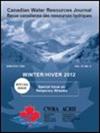Assessment of the ability of the standardized precipitation evapotranspiration index (SPEI) to model historical streamflow in watersheds of Western Canada
IF 0.9
4区 环境科学与生态学
Q3 WATER RESOURCES
引用次数: 3
Abstract
Abstract Knowledge of present-day spatial and temporal distribution of water resources is vital for successful water management and policies for planned adaptation to climate change. Measured quantities of hydroclimatic variables, including precipitation, evapotranspiration, streamflow, etc., are the primary indicators of water availability, and indices derived using several such primary variables provide a means to express water availability across a range of spatio-temporal scales. In this study, the ability of one such multi-scalar index, the Standardized Precipitation Evapotranspiration Index (SPEI), computed at a range of time scales, was examined to see how well it could model historically observed warm season monthly and annual streamflow in 24 natural-flowing watersheds of western Canada. The empirical relationships between the SPEI, computed at 1-, 3-, 6-, 9-, 12- and 24-month time scales, and monthly and annual streamflow were analyzed, showing significant correlations for all watersheds. The time scale of the SPEI with the strongest correlations varied seasonally. Based on these results, SPEI-based principal component regression (PCR) equations were calculated to model warm season monthly and annual historical streamflow. These PCR equations are able to adequately capture historical streamflow in these watersheds. Annual streamflow variability was better captured (mean = 0.46) than monthly variability (mean = 0.30 over March–October). Summer and fall streamflow variability was better captured (mean = 0.42 over June–September) than spring variability (mean = 0.15 over March–April).标准化降水蒸发蒸腾指数(SPEI)模拟加拿大西部流域历史径流的能力评估
摘要了解当今水资源的空间和时间分布对于成功的水管理和有计划地适应气候变化的政策至关重要。水文气候变量的测量量,包括降水量、蒸散量、流量等,是水资源可用性的主要指标,使用几个这样的主要变量得出的指数提供了一种在一系列时空尺度上表达水资源可用度的方法。在这项研究中,检验了一个这样的多标量指数,即在一系列时间尺度上计算的标准化降水蒸发蒸腾指数(SPEI)的能力,以了解它在多大程度上能够模拟加拿大西部24个自然流动流域历史上观测到的暖季月和年径流。分析了在1、3、6、9、12和24个月时间尺度上计算的SPEI与月流量和年流量之间的经验关系,显示出所有流域的显著相关性。相关性最强的SPEI的时间尺度随季节变化。基于这些结果,计算了基于SPEI的主成分回归(PCR)方程,以模拟暖季月度和年度历史流量。这些PCR方程能够充分捕捉这些流域的历史流量。年流量变化率(平均值=0.46)比月变化率(3月至10月平均值=0.30)更好地捕捉到。夏季和秋季的流量变化(6月至9月的平均值=0.42)比春季的变化(3月至4月的平均数=0.15)更好地捕捉到。
本文章由计算机程序翻译,如有差异,请以英文原文为准。
求助全文
约1分钟内获得全文
求助全文
来源期刊

Canadian Water Resources Journal
WATER RESOURCES-
CiteScore
2.90
自引率
5.90%
发文量
17
审稿时长
>12 weeks
期刊介绍:
The Canadian Water Resources Journal accepts manuscripts in English or French and publishes abstracts in both official languages. Preference is given to manuscripts focusing on science and policy aspects of Canadian water management. Specifically, manuscripts should stimulate public awareness and understanding of Canada''s water resources, encourage recognition of the high priority of water as a resource, and provide new or increased knowledge on some aspect of Canada''s water.
The Canadian Water Resources Journal was first published in the fall of 1976 and it has grown in stature to be recognized as a quality and important publication in the water resources field.
 求助内容:
求助内容: 应助结果提醒方式:
应助结果提醒方式:


